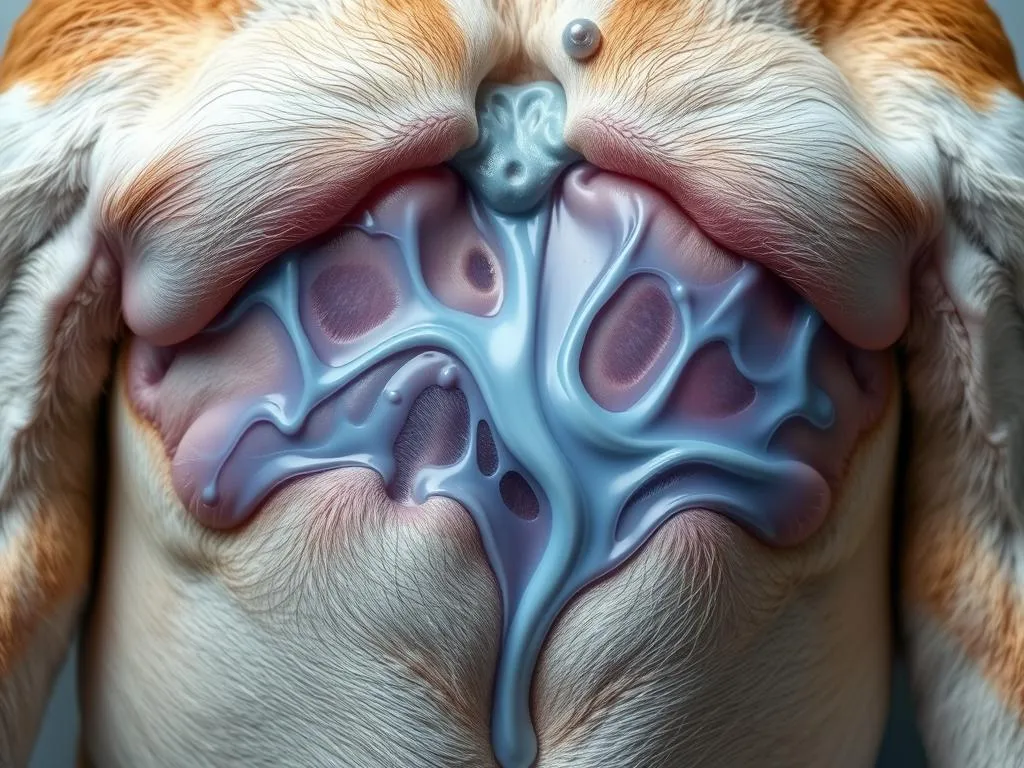
Introduction
Fluid accumulation in dogs’ abdomen, medically known as ascites, refers to an abnormal buildup of fluid in the abdominal cavity. This condition can be a sign of various underlying health issues, ranging from mild to severe. As pet owners, understanding the implications of fluid in dogs’ abdomen is crucial, as it can indicate serious health problems requiring prompt veterinary care.
Being aware of the potential seriousness of ascites can help in early detection and treatment, which is essential for the well-being of your furry companions. This article aims to educate readers on the causes, symptoms, diagnosis, and treatment options available for dogs suffering from this condition.
Understanding Abdominal Fluid in Dogs
What is Ascites?
Ascites is characterized by an accumulation of fluid in the abdominal cavity. This excess fluid can arise from various medical conditions and can lead to significant discomfort and health risks for the affected dog. The abdominal cavity, which normally contains a small amount of lubricating fluid, can become distended with excessive fluid, affecting organ function and overall health.
Types of Fluid Accumulation
There are different types of fluid that can accumulate in a dog’s abdomen, each with distinct characteristics and underlying causes.
-
Transudate: This type of fluid is typically clear and is caused by increased pressure in the blood vessels or low protein levels in the blood. Common causes include liver disease and heart failure.
-
Exudate: This fluid is usually cloudy and can contain high levels of proteins and cells. It often indicates inflammatory conditions or infections, such as those caused by cancer or bacterial infections.
-
Chylous Fluid: This milky fluid is high in fat and can result from issues in the lymphatic system, such as lymphatic obstruction or trauma.
Causes of Fluid Accumulation
Common Causes
-
Heart Disease: Heart conditions can lead to congestive heart failure, causing blood flow issues that result in fluid leakage into the abdomen.
-
Liver Disease: The liver plays a crucial role in protein production. When it is diseased or dysfunctional, it can lead to low protein levels in the blood, resulting in ascites.
-
Cancer: Certain types of cancers, particularly those affecting the abdomen (e.g., liver tumors, lymphosarcoma), can lead to fluid accumulation.
-
Infections: Bacterial, viral, and parasitic infections can cause inflammation and fluid buildup. For example, leptospirosis can lead to kidney damage and ascites.
Less Common Causes
-
Trauma: Physical injuries, such as those from accidents, can lead to bleeding or fluid leakage into the abdominal cavity.
-
Pancreatitis: Inflammation of the pancreas can cause severe abdominal pain and fluid accumulation, potentially leading to ascites.
-
Hypoalbuminemia: Low levels of albumin, a protein in the blood, can result in fluid leaking into surrounding tissues, including the abdomen.
Symptoms to Watch For
Physical Signs
-
Swollen Abdomen: One of the most noticeable signs of fluid in the abdomen is a visibly swollen belly, which can be accompanied by discomfort when touched.
-
Difficulty Breathing: As fluid accumulates, it can put pressure on the diaphragm, making it hard for the dog to breathe comfortably.
-
Lethargy and Weakness: A dog with abdominal fluid may exhibit decreased energy levels, showing reluctance to play or engage in normal activities.
Behavioral Indicators
-
Loss of Appetite: A sudden decrease in appetite can be a concerning sign, especially if accompanied by other symptoms.
-
Vomiting: Dogs may experience digestive distress, leading to vomiting, which can complicate their condition further.
-
Changes in Urination: Alterations in urination patterns, such as increased frequency or difficulty urinating, can indicate underlying health issues.
Diagnosis of Fluid in Dogs’ Abdomen
Initial Veterinary Examination
During a veterinary exam, the veterinarian will perform a thorough physical examination, checking for signs of abdominal distension or discomfort. They may also inquire about the dog’s medical history and any recent changes in behavior or symptoms.
Diagnostic Tools
-
Ultrasound: This imaging technique is crucial for visualizing the abdomen and identifying the presence and cause of fluid accumulation.
-
X-rays: X-rays can help assess the structure of the abdominal organs and identify any abnormalities contributing to fluid buildup.
-
Fluid Analysis: A needle may be inserted into the abdomen to extract fluid for analysis. This can help determine the type of fluid and the underlying cause of the ascites.
Treatment Options
Medical Management
-
Medications: Depending on the underlying cause, veterinarians may prescribe diuretics to help reduce fluid buildup or anti-inflammatories to manage pain and inflammation.
-
Nutritional Support: Dietary adjustments can aid recovery. For instance, low-sodium diets may help in cases related to heart disease.
Surgical Interventions
-
Laparocentesis: This is a procedure where a needle is inserted into the abdomen to remove excess fluid. It can provide immediate relief for the dog and can also be used for diagnostic purposes.
-
Surgery for Underlying Conditions: If the fluid buildup is due to a specific issue, such as a tumor or severe infection, surgical intervention may be necessary to address the root cause.
Home Care and Management
Monitoring Your Dog
During recovery, it’s essential to monitor your dog closely for any signs of improvement or deterioration. Key indicators include changes in appetite, energy levels, and abdominal swelling.
Lifestyle Adjustments
-
Dietary Changes: Implementing a balanced diet that is low in sodium and rich in essential nutrients can help manage fluid levels and promote recovery.
-
Exercise and Activity: While it’s important to keep your dog active, ensure that exercise is balanced and does not exacerbate their condition. Gentle walks and light play can be beneficial.
Prevention Strategies
Routine Veterinary Check-ups
Regular health assessments can help identify potential health issues before they become severe. Routine check-ups can also ensure that any underlying conditions are monitored and managed effectively.
Maintaining a Healthy Lifestyle
- Balanced Diet and Exercise: Providing a nutritious diet and regular exercise can significantly reduce the risk of conditions that lead to ascites. Keeping your dog at a healthy weight is crucial for overall health.
Conclusion
Understanding fluid in dogs’ abdomen is essential for every pet owner, as it can signify serious health concerns. By recognizing the causes, symptoms, and treatment options available, you can take proactive steps to ensure your dog receives the care they need. Always consult a veterinarian if you suspect your dog may be suffering from ascites or any other health issue. Remember, a strong bond with your pet includes proactive health management and support throughout their lives.
FAQs
-
What should I do if I suspect my dog has fluid in their abdomen?
If you notice symptoms such as a swollen abdomen or difficulty breathing, consult your veterinarian immediately for an evaluation. -
Can fluid in a dog’s abdomen be treated at home?
While some mild cases might be managed with dietary changes, it’s essential to seek professional veterinary care for proper diagnosis and treatment. -
How serious is fluid accumulation in dogs?
Fluid accumulation can indicate significant underlying health issues; thus, timely veterinary intervention is crucial. -
Are certain breeds more prone to abdominal fluid issues?
While any dog can develop ascites, some breeds predisposed to heart and liver diseases may be more susceptible to fluid accumulation. Regular check-ups can help monitor their health.









